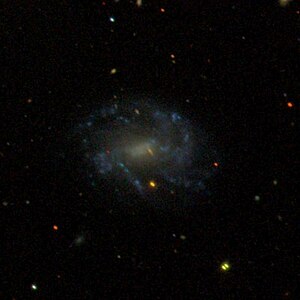NGC 4512
| Galaxy NGC 4512 = NGC 4521 |
|
|---|---|

|
|
| SDSS recording | |
| AladinLite | |
| Constellation | Dragon |
|
Position equinox : J2000.0 , epoch : J2000.0 |
|
| Right ascension | 12 h 32 m 47.6 s |
| declination | + 63 ° 56 ′ 21 ″ |
| Appearance | |
| Morphological type | S0-a |
| Brightness (visual) | 12.2 mag |
| Brightness (B-band) | 13.1 mag |
| Angular expansion | 2.5 'x 0.6' |
| Position angle | 167 ° |
| Surface brightness | 12.5 mag / arcmin² |
| Physical data | |
| Affiliation |
NGC 4521 group LGG 295 |
| Redshift | 0.008376 ± 0.000017 |
| Radial velocity | 2511 ± 5 km / s |
|
Stroke distance v rad / H 0 |
(117 ± 8) x 10 6 ly (36.0 ± 2.5) Mpc |
| history | |
| discovery | William Herschel |
| Discovery date | March 20, 1790 |
| Catalog names | |
| NGC 4512/4521 • UGC 7706 • PGC 41621 • CGCG 315-046 • MCG + 11-15-061 • 2MASX J12324772 + 6356214 • GC 3062/3071/3069 • H II 849 • h 1321/1326 • LDCE 889 NED009 | |
NGC 4512 = NGC 4521 is a lenticular galaxy of the Hubble type S0 / a in the constellation Dragon in the northern sky . It is estimated to be 117 million light years from the Milky Way and about 85,000 light years in diameter.
In the same area of the sky are u. a. the galaxies NGC 4481 , NGC 4510 , NGC 4545 .
The type II supernova SN 1995J was observed here.
The object was discovered on March 20, 1790 by William Herschel using his 18.7-inch reflecting telescope (listed as NGC 4521 ) and on April 3, 1832 by his son John Herschel (listed as NGC 4512 ).
